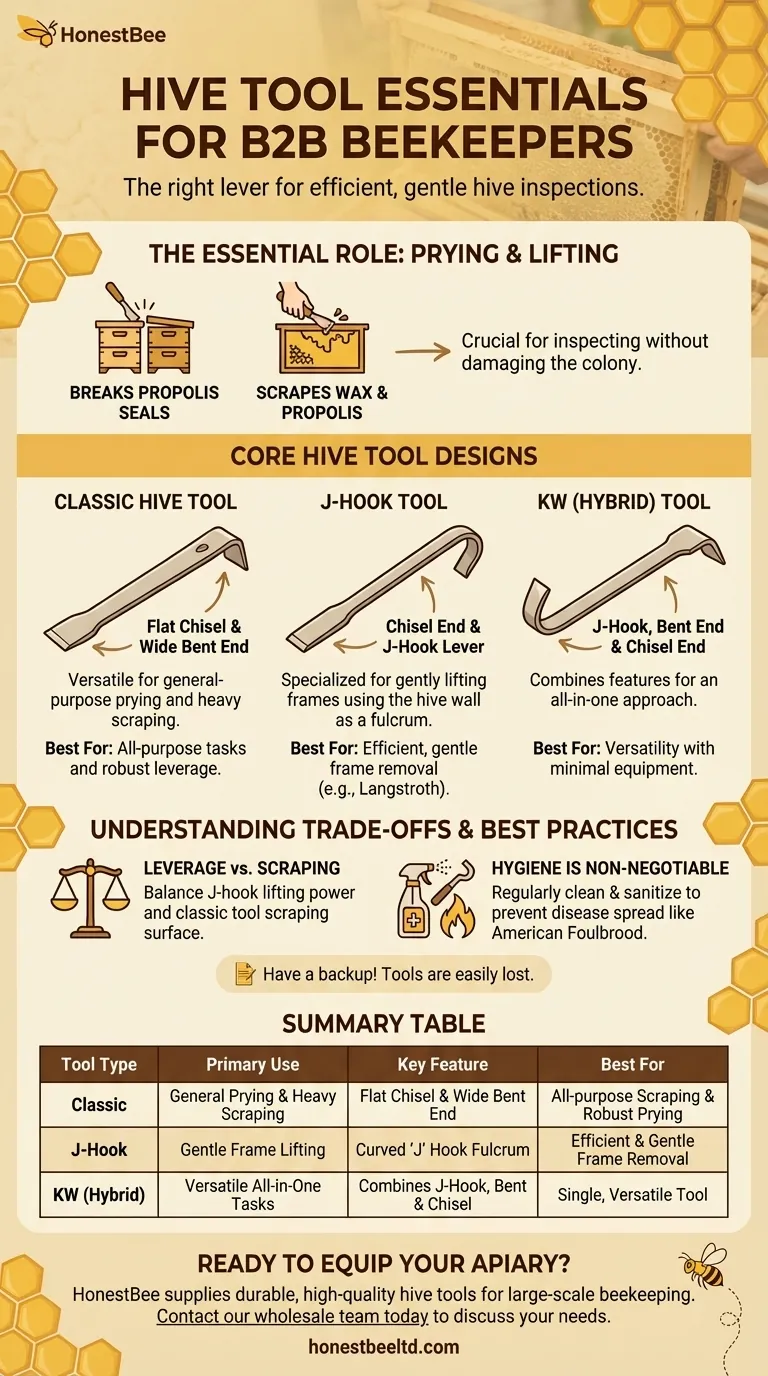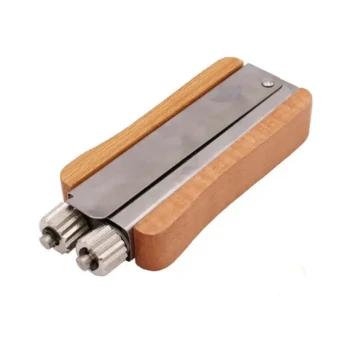In beekeeping, the primary types of hive tools available are the classic (or standard) hive tool, the J-hook tool, and hybrid designs like the KW tool. These simple metal bars are not just accessories; they are arguably the most essential piece of equipment a beekeeper owns, used to pry, scrape, and lift components sealed shut by the bees' propolis.
The choice of a hive tool is more than a matter of preference; it's about selecting the right lever for the job. Your goal is to work efficiently and gently, and the tool's design directly impacts your ability to inspect the hive without causing undue stress or damage to the colony.

The Essential Role of the Hive Tool
A modern beehive is designed with precise spacing, but bees use a sticky resin called propolis to seal every crack and seam. This makes the hive a single, solid unit that is impossible to inspect without a strong lever.
Why You Can't Work Without One
Without a hive tool, a beekeeper cannot perform basic, critical tasks. It is essential for cracking the seal on the hive lid (crownboard), separating hive bodies, and prying frames apart for inspection.
Attempting an inspection without one is inefficient and potentially harmful. You risk damaging the woodenware and, more importantly, rolling or crushing bees as you struggle to separate components.
The Two Core Functions: Prying and Lifting
All hive tools serve two fundamental purposes. First, they act as a pry bar to separate hive boxes and loosen frames. Second, they function as a scraper to remove excess beeswax and propolis from hive components, keeping your equipment clean and functional.
The Core Hive Tool Designs
While many variations exist, almost all hive tools are based on two fundamental designs, with a third hybrid option combining the best of both.
The Classic Hive Tool
This is the traditional, dual-purpose design. One end is a flat, chisel-like blade for prying and heavy scraping. The other end is bent at a right angle, creating a wider surface perfect for scraping frame tops or prying with more leverage.
Its strength is its versatility as a general-purpose prying and scraping instrument. However, it offers less finesse for lifting frames.
The J-Hook Hive Tool
The J-hook tool is a more specialized design focused on one critical task: lifting frames. It features a standard straight, chisel-like end for prying and scraping.
Its defining feature is the other end, which has a small, curved "J" shape. This hook is designed to fit over the top bar of a frame, allowing you to use the hive wall as a fulcrum to easily lever the frame up without damaging it or jarring the bees.
The KW (Hybrid) Tool
As the name suggests, a hybrid tool attempts to combine the features of the classic and J-hook designs into a single unit.
It typically includes a J-hook for lifting frames, a bent end for scraping and prying like the classic tool, and a straight chisel end. This "all-in-one" approach is convenient, though some find dedicated tools to be slightly more effective at their specific tasks.
Understanding the Trade-offs
Choosing a hive tool involves balancing leverage, scraping efficiency, and personal workflow. There is no single "best" tool, only the best tool for a specific task or beekeeper.
Leverage vs. Scraping Surface
The primary trade-off is between the lifting power of a J-hook and the broad scraping surface of a classic tool.
A J-hook makes lifting the first, tightly packed frame from a hive box significantly easier and gentler. A classic tool, with its wider bent end, is often more effective for scraping large amounts of propolis and burr comb off the top bars of an entire box.
The Inevitability of Loss
Hive tools are notoriously easy to misplace in the grass during an inspection. Many experienced beekeepers own several, often painting them bright colors to make them easier to find. Having a backup is a wise investment.
Hygiene is Non-Negotiable
A hive tool is a primary vector for the spread of disease between hives. When you scrape propolis or inspect a frame, the tool can pick up spores and pathogens, such as those causing American Foulbrood.
It is critical to clean and sanitize your hive tool regularly, especially after working in a hive that shows any signs of sickness and before moving to a healthy one. A simple spray bottle of rubbing alcohol or a quick scorch with a blowtorch works well.
Making the Right Choice for Your Goal
Your choice should be guided by the type of hive you use and the challenges you face most often.
- If your primary focus is gentle frame removal in a Langstroth hive: The J-hook tool is the superior choice, as lifting the first frame is often the most difficult step in an inspection.
- If you prioritize all-purpose scraping and heavy prying: The classic hive tool provides excellent scraping surfaces and robust prying capability.
- If you want a single tool that can do everything reasonably well: A KW hybrid tool offers the most versatility and is an excellent option for a beekeeper who wants to carry minimal equipment.
Ultimately, your hive tool is the extension of your hands, enabling you to work in partnership with your bees with confidence and care.
Summary Table:
| Tool Type | Primary Use | Key Feature | Best For |
|---|---|---|---|
| Classic Hive Tool | General prying & heavy scraping | Flat chisel blade & wide bent end | All-purpose scraping and robust prying |
| J-Hook Tool | Gentle frame lifting | Curved 'J' hook for using the hive wall as a fulcrum | Efficient and gentle frame removal in Langstroth hives |
| KW (Hybrid) Tool | Versatile all-in-one tasks | Combines J-hook, bent end, and chisel end | Beekeepers wanting a single, versatile tool |
Ready to equip your apiary with the right tools?
As HONESTBEE, we supply durable, high-quality hive tools and beekeeping equipment to commercial apiaries and distributors through our wholesale-focused operations. We understand the demands of large-scale beekeeping and provide the reliable gear you need to work efficiently and protect your investment.
Contact our wholesale team today to discuss your hive tool requirements and see how we can support the health of your colonies and the productivity of your operation.
Visual Guide

Related Products
- Professional Stainless Steel Pry-Bar Hive Tool
- HONESTBEE Premium Italian Style Hive Tool with Hardwood Handle
- HONESTBEE Advanced Ergonomic Stainless Steel Hive Tool for Beekeeping
- HONESTBEE Professional Multi-Functional Hive Tool with Ergonomic Wood Handle
- Multi-Function Plier-Style Frame Grip Hive Tool
People Also Ask
- Why is it recommended to have multiple hive tools on hand? Essential Tips for Efficient Beekeeping
- What additional safety equipment should beekeepers use? Essential Tools for Hive Management
- What is the correct method for lifting frames with a hive tool? Master the Technique for a Calm Hive
- What are the parts of a hive tool? Master Your Hive Inspections with the Right Tool
- What equipment and implements are needed by beekeepers besides the hives? Build Your Essential Beekeeping Toolkit



















